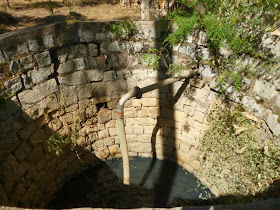The lakes
in and around the Sarjapura road area need to be understood in greater detail to study their role in the ground water situation in the Sarjapur - Bellandur region. A
quick tour of nine lakes revealed the following information.
v Singasandra
lake: Located at 12º52’56.71” N latitude, 77º38’40.84” E longitude, and an altitude of 842 m.
BBMP has de-silted the lake with an aim to convert it into a park. The lake
area is about 10acres, of which the water body occupies about 8acres. By
de-silting, the idea is to make the lake fit for collection of rain water;
discharge of wastes into the lake is also being stopped.
Illustration
1: Singasandra Lake
v Kudlu
lake: Located at 12º53’10.47” N latitude, 77º39’58.8” E longitude and 813 m
altitude. The lakebed is at present dry. A small pond of water is found inside
the kudlu village which is surrounded by naturally formed rocks. This is
important as the water looks clean. This pond is located at 12º53’1.66” N
latitude, 77º39’21” E and 842 m altitude.
Illustration
2: Kudlu Lake and nearby ‘Bandi’
v Parappana
Agrahara lake: Located at 12º52’46.8” N latitude, 77º39’36.48” E longitude and
831 m altitude. According to the residents of the area, the lake has been
filled.
Illustration
3: Parapana Agrahara Lake
v Kodige
Singasandra lake: Located at 12º52’46.30” N latitude, 77º38’32.32” E longitude
and 846 m altitude. According to a local, till a couple of years ago, the lake
was used as a source for drinking water and fishermen were earning their
livelihood by catching the fishes from the lake. But now, the apartments and garment
industries around the lake discharge untreated sanitary wastes and the chemical
wastes into the lake. The person also added that people have complained about
the sorry state of the lake to the BBMP but the authority has failed to take
suitable action against the polluters.
Illustration
4: Kodige Singasandra Lake
v Begur
lake: Located at 12º52’41.43” N latitude, 77º37’57.24” E longitude and an
altitude of 818 m. The lake was filled with wastes.
v Chikka
Begur lake: Located at 12º53’1.38” N latitude, 77º38’17.63” E longitude and 816
m altitude. A large number of plants can be seen in this lake.
Illustration
5: Begur and Chikka Begur Lakes
v Doddakanneli
lake: Located at 12º54’46.17” N latitude, 77º41’44.77” E longitude and 809 m
altitude. The lake was de-silted, the sanitary waste, previously discharged
into this, is now diverted to a separate gutter. The lake will be soon surrounded
by roads, and will only depend on rainfall for its water.
Illustration
6: Doddakanneli Lake
v Dommsandra
lake: Located at 12º52’36.19” N latitude, 77º45’4.09” E longitude and 828 m
altitude. Lake is filled with soil, it has a borewell nearby which is in
working condition.
Illustration
7: Dommasandra Lake
v Somasundra
Palya lake: Located at 12º53’56.77” N latitude, 77º38’55.14” E longitude and
860 m altitude. The lake is filled with sewage. The lake area is about 16 acres
and 29 guntas.
Illustration 8: Somasundra Palya Lake












